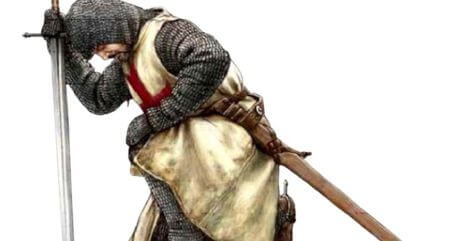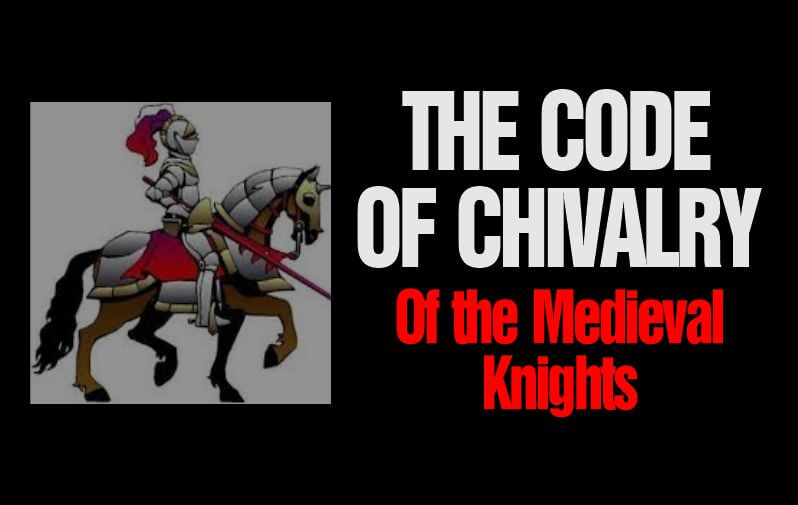The Code of Chivalry might no longer make a splash, but its echoes linger everywhere you look, and the lessons it teaches will remain for generations to come.
The code of chivalry, a set of rules that guided the medieval knights, represents a fascinating blend of honor, bravery, and virtue.
Entrenched in the turbulent times of medieval Europe, this code guided knights in their quest for glory and respect.
From gallant deeds on the battlefield to noble behaviour in courtly affairs, the Code of Chivalry reveals the timeless values that shaped an era of legendary valor and integrity.
Key Takeaways
- The Code of Chivalry, from medieval Europe, still promotes honor, bravery, respect, and kindness.
- Code of Chivalry guided knights’ daily behavior, encouraging courtesy, generosity, and respect.
- The Code of Chivalry showed honorable conduct and bravery in warfare, shaped military strategies, and influenced knights’ participation in social events.
- With the decline of feudalism and the rise of professional armies, chivalry evolved into a refined code associated with courtly behavior and social refinement.
Table of Contents
- Key Takeaways
- What is the Code of Chivalry?
- Historical Background of the Code of Chivalry
- Is the Code of Chivalry Still Relevant Today?
- Knights’ Code of Chivalry
- The 10 Commandments of Chivalry
- Symbolism and Traditions Associated with the Code of Chivalry
- Daily Life of a Knight Governed by the Code of Chivalry
- The Code of Chivalry in Warfare
- The Decline of Knighthood and Feudalism
- Frequently Asked Questions
- Conclusion
What is the Code of Chivalry?
The Code of Chivalry is a moral system that emerged in medieval Europe, governing the expected behaviors and virtues of knights who were medieval gentleman-soldiers born high and usually trained by privileged military status after completing training as pages.. It encouraged ideals such as honor, bravery, respect for women, and the protection of the weak.
Historical Background of the Code of Chivalry

The Code of Chivalry emerged in the 12th century as a response to the chaotic and violent medieval period, providing moral and ethical guidelines for knights.
Rooted in ancient military practices, it was refined by medieval knights who aimed to bring order and civility to warfare.
This code combined martial prowess, religious devotion, and a commitment to honor, courtesy, and loyalty, transforming warriors into paragons of virtue.
Inspired by tales of King Arthur and his Knights of the Round Table, the Code of Chivalry served as a moral compass, guiding knights in their noble pursuits and actions.
See a dedicated post on the history of chivalry.
Is the Code of Chivalry Still Relevant Today?
The Code of Chivalry remains relevant in modern society, guiding us to prioritize the well-being of others over self-interest.
It hammers on kindness, empathy, and dignity, encouraging us to be courageous in defending what is right.
Chivalry promotes personal growth and harmonious relationships, inspiring us to listen, speak courteously, and help those in need.
It transcends gender, reminding us that honor and courage are universal values.
By embracing chivalry, we can hone a community that values integrity and kindness, strengthening bonds and uplifting the human spirit.
Related: Outdated Chivalrous Behaviours Men Should Abandon
Knights’ Code of Chivalry
1. Honour and Integrity
Honor and integrity are foundational to the Code of Chivalry, reflecting the ideals that guide knights.
Honor compels knights to uphold truth and justice, ensuring trust through reliability and dedication.
Integrity, the armor of the soul, demands consistency between actions and values, protecting against deceit.
In a world rife with moral ambiguity, these virtues serve as guiding stars, urging steadfastness and strong character.
They are essential to the chivalric code, transcending time and inspiring true commitment to righteousness.
Related: Why People Think Chivalry is Dead
Related: How a Gentleman Can Win the Heart of a Lady
2. Courage and Bravery
Courage and bravery were fundamental principles within the Code of Chivalry.
Knights were expected to display unflinching bravery in the face of danger, to protect the weak, and to stand up for justice, even at personal risk.
True courage encompassed moral fortitude, resilience, and the ability to confront one’s own fears.
Bravery was not limited to the battlefield but required knights to act with integrity in all aspects of life.
Courage was the foundation upon which knights earned respect and admiration.
Related: Courtly Romance and the Rules Guiding it
3. Loyalty and Devotion
Courage and bravery were revered as fundamental principles within the Code of Chivalry.
Knights were expected to display unwavering bravery in the face of danger, to protect the weak, and to stand up for justice, even at personal risk.
True courage encompassed moral fortitude, resilience, and the ability to confront one’s own fears.
Bravery was not limited to the battlefield but required knights to act with integrity in all aspects of life.
Courage was the foundation upon which knights earned respect and admiration.
4. Respect and Courtesy
Respect and courtesy were core principles of the Code of Chivalry, guiding knights in their interactions.
Knights were expected to treat everyone with dignity, regardless of status, and to exhibit politeness and consideration.
These values reflected a knight’s character, emphasizing that true strength lies in kindness and empathy, rather than arrogance.
Related: Modern Chivalry for Navigating Modern Society
5. Protection of the Weak and Defenseless
Protecting the weak and defenseless was a core principle of the Code of Chivalry.
Knights were expected to use their strength to shield the vulnerable, including women, children, the elderly, and the oppressed.
They stood against tyranny and advocated for justice, ensuring fair treatment for all.
6. Justice and Fairness
Justice and fairness played a key role in the Code of Chivalry by serving justice and fairness. It is easy for the rich and mischievous in society to use their wealth and power to oppress the lowly. It is also easy to be a victim of bias when favour is given.
Even though there were cases of corrupt knights, generally, justice and fairness made knights uphold the virtue of justice and fairness. They exercised the ability to deliver truthful judgment without favour and could be seen in making sure the weak and the lowly were not shoved further into the bottom of society.
Related: The Meaning of a Distinguished Gentleman
The 10 Commandments of Chivalry
Apart from the principles and values of the code of chivalry, the following commandments also guided the life of knights.
However, these rules were not consistent with many groups, as each group had different views on chivalry.
The Commandments of Chivalry
- Thou shalt believe all that the Church teaches and thou shalt observe all its directions.
- Thou shalt defend the Church.
- Thou shalt respect all weaknesses, and shalt constitute thyself the defender of them.
- Thou shalt love the country in which thou wast born.
- Thou shalt not recoil before thine enemy.
- Thou shalt make war against the infidel without cessation and without mercy.
- Thou shalt perform scrupulously thy feudal duties, if they are not contrary to the laws of God.
- Thou shalt never lie, and shalt remain faithful to thy pledged word.
- Thou shalt be generous, and give largesse to everyone.
Wikipedia
- Thou shalt be everywhere and always the champion of the Right and the Good against Injustice and Evil.
Symbolism and Traditions Associated with the Code of Chivalry
The Code of Chivalry was known to have some traditions revolving around it, which it unfolded for the spectacles of the public.
Here are the associated traditions that chivalry was proudly displayed:
Heraldry and Coat of Arms
Heraldry, with its majestic coat of arms, served as a visual language that spoke volumes about a knight’s lineage, achievements, and allegiances.
These intricate designs adorned shields, banners, and attire, symbolizing the knight’s identity and affiliation.
Heraldry, passed down through generations, not only included family pride but also became a means of recognition and honour on the battlefield.
The Chivalric Order and Knighthood Ceremonies
The chivalric order was a revered institution that bestowed knighthood upon worthy individuals.
These orders, such as the Knights Templar or the Order of the Garter, held strict codes of conduct and ideals.
The path to knighthood involved a solemn ceremony, often conducted in a grand setting.
This sacred rite transformed the aspirant into a knight, binding them to the principles of chivalry and marking their entry into an esteemed brotherhood.
Tournaments and Jousting
Tournaments and jousting emerged as vibrant spectacles that reflected the valour and skill of knights.
These events showcased the prowess of combatants, providing a platform for knights to demonstrate their mastery of the martial arts.
The joust, in particular, symbolized the knight’s courage, horsemanship, and accuracy.
These thrilling contests served not only as entertainment but also as opportunities for knights to prove themselves and gain renown.
Courtly Love and Romantic Ideals
Courtly love is mostly an art that makes chivalry popular in today’s people. This is what people of today remember chivalry for – sneaking into the hearts of women.
Courtly love was a knightly tradition of love and romance between a married noblewoman and a knight who was an architect of the troubadours of France which was extensively practiced in Europe at the time.
Courtly love celebrated the purity and devotion between a knight and a noble lady, imbued with the essence of admiration, reverence, and unreciprocated love.
This unrequited desire spurred the knights to perform great dangerous feats of valour to get the admiration of their desired ladies.
These traditions and symbols formed a rich love situation of medieval society, interwoven with the ideals and aspirations of chivalry.
They elevated the knightly experience, bestowing a sense of identity, purpose, and a framework for noble behaviour.
Daily Life of a Knight Governed by the Code of Chivalry
Chivalric values were central to a knight’s identity and daily life, emphasizing courtesy, generosity, and respect for all.
Their daily routines included combat training, community involvement, and participation in local governance.
The Code of Chivalry guided both military conduct and social interactions, with knights demonstrating bravery in battle, participating in tournaments, and showcasing their virtues at social events.
They also supported the arts, reinforcing their ideals and cultural contributions.
The Code of Chivalry in Warfare
The Code of Chivalry significantly influenced knights’ conduct in medieval warfare, emphasizing both martial skill and moral integrity.
Knights were expected to behave honorably, showing bravery and courtesy even towards enemies, and protecting the weak and defenseless.
This commitment to chivalric principles established order in combat, promoting structured military strategies and camaraderie among knights.
Tournaments became venues for demonstrating skills and adhering to these values, while the code also legitimized warfare by framing battles as righteous causes, encouraging alliances based on shared honor and loyalty.
The Decline of Knighthood and Feudalism
As the medieval period gave way to new epochs, the traditional structures of knighthood and feudalism gradually collapsed.
With the rise of centralized monarchies and the advent of gunpowder warfare, the role of knights as mounted warriors diminished.
The decline of feudalism and the emergence of professional armies brought about a shift in power and social dynamics, leading to a decline in the prominence of chivalry as a way of life.
Also, fast-forward to the Renaissance and Enlightenment eras, chivalry experienced a metamorphosis as it transformed from a warrior-centric code into a more refined set of values associated with courtly behavior and gentlemanly conduct.
The emphasis shifted towards intellectual pursuits, social refinement, and the cultivation of arts and literature.
The ideals of chivalry found expression in the works of Renaissance thinkers, who championed virtues such as wisdom, reason, and civility.
Frequently Asked Questions
What was the medieval knights code of chivalry?
The medieval knights’ code of chivalry was a set of moral and social rules that emphasized virtues like honor, loyalty, bravery, and courtesy.
What are the 10 Commandments of the Code of Chivalry?
The 10 Commandments of the Code of Chivalry varied, but common principles included defending the weak, being truthful, showing mercy, and honoring one’s word.
What are the six standards of the chivalric code?
The six standards of the chivalric code often included loyalty, courage, honor, justice, generosity, and courtesy, guiding knights in their conduct and interactions.
What are the 4 codes of chivalry?
The four codes of chivalry typically cover loyalty to God, loyalty to the feudal lord, loyalty to the lady of the heart, and the defense of the weak and oppressed.
Conclusion
The Code of Chivalry and the gallant medieval knights stand as beacons of honour and virtue to date.
Their legacy, forged through medieval times, continues to inspire and captivate our imaginations.
The ideals of chivalry, with its emphasis on honour, courage, justice, and respect, transcend the ages, reminding us of the noble potential within humanity.
While the world has changed, and the clatter of armor has faded, the spirit of chivalry endures, calling us to be knights in our own right, wielding the sword of integrity and championing the timeless values that defined the knights of old.
Citations:
- https://www.medieval-life-and-times.info/medieval-knights/code-of-chivalry.htm
- https://www.worldhistory.org/Medieval_Chivalry/
- https://www.worldhistory.org/Medieval_Chivalry/
- https://chivalrytoday.com/the-u-s-army-chivalry/
- https://www.abdn.ac.uk/sll/disciplines/english/lion/chivalry.shtml
Pyo Merez is a men’s lifestyle enthusiast and writer about the gentleman’s place and impact on society. Raised by a distinguished gentleman dad, he offers unique insights into how the mind of a gentleman works and how societal norms shape gentlemen’s identity and vice versa.
Through his insightful articles, Pyo taps into the depths of gentleman culture to provide perspectives on etiquette and manners in modern society.

